Double Play
In executing a double play there is no one position more important than another, they are interconnected, but the shortstop, because of all the ground he must cover, usually initiates more plays than the other infield positions. He and his counterpart, the second baseman, must actually be mind readers, anticipating what one another will do in a particular situation, and that only comes with practicing and playing together.
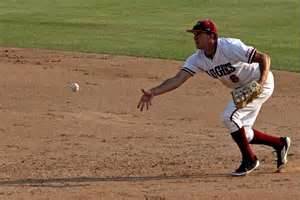
Under Hand Toss
No different from any other infielder, the shortstop must not only field the ball, but be able to quickly move into a position where he can deliver a strong throw, and there are two basic, but different ways to position your body to throw the ball to the second baseman.
Balls Hit at You:
Upon catching the ball you…
(1.) Open your hips, turning your left foot towards second base, while pivoting on the balls of your right foot, turning the body;
(2.) Push off the back foot and throw.
Quick Flip:
(1.) A quick flip depends on the arm strength of the shortstop and the location he’s at in relation to second base.
(2.) Upon catching the ball, twist at the hips, facing second base with your body, and without moving your feet, use a side arm release to throw the ball.
(a.) You never use a Crow Hop when making a double play as it requires too much time. The only exception would be the third baseman who would be facing and moving towards second base upon catching the ball, then a natural crow hop would flow into his throwing motions.
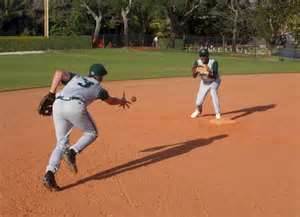
There are numerous variables, speed and location of the ball, positioning of your body when making the catch, stretched forward or fielding the ball backhanded, which will affect the method of your delivering the ball to the second baseman.
When practicing remember these 2 key actions;
(1.) Hold the baseball out away from your body so the second baseman can clearly see it;
(2.) The throw should be chest high to allow for an easy catch, ball transfer and throw.
Clickbank Products
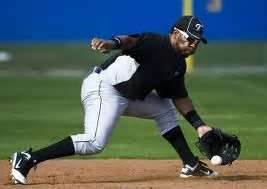
Preparing To Spin
Controlling Forward Momentum:
Both middle infielders, Shortstop & Second, will be forced to field balls hit far to their left, which will require them to overextend, having their head and body weight far ahead of their hips, which will create an off balance condition.
If the fielder must continue running another 3 or 4 steps, in order to regain balance, there will not be enough time for them to stop, turn and throw in order to complete a double play.
Therefore, if you can not stop the forward momentum required to make the play, what else can be done?
You regain control over momentum not by stopping it, but by redirecting it.
(1.) As the Shortstop catches the ball, he will immediately begin to raise his upper body;
(2.) As he raises, he will spin towards his left, (always Left Field) turning his body around and slowing his momentum;
(3.) As he completes his circling turn, he pauses, remember he’s not in total control, and throws in one continuous motion to the base.
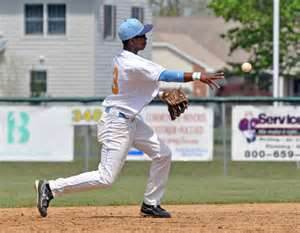
Nice & Fluid
(3.) Depending on his proximity to second base … he could throw a back handed toss to the fielder.
The second baseman will perform the exact physical actions as the shortstop, only in he’d turn towards right field, slowing and throwing to second base.
The Third and First Baseman will rarely be forced to ever use this maneuver, as any ball they range far to their side to catch they will be moving towards their intended target and will continue to run as they throw, as balls to the other side will be foul.
Back Handed Catches
Fielders always want to field the ball on their glove side and will circle a ball if necessary to accomplish this, but sometimes that’s just not possible. The ball will be hit so hard to the infielder’s’ “ throwing hand side “ they won’t be able to react in any other way except to back hand the ball.
(1.) Turn your glove hand wrist backwards, turning your open glove face to the ball;
(2.) Upon catching the baseball, immediately plant your right foot, assuming a right handed thrower;
(c.) Raise and Throw… pushing off the plant foot.
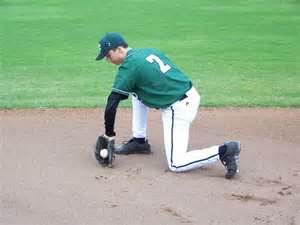
The Double Play - First Base
Regardless whether the first baseman is left or right handed, their job is to field and immediately throw the ball to second base.
(a.) A Left handed fielder quickly shifts his body, either by taking a small step with his left foot and turning his hips or taking a step towards second base, and throws an overhand or a 3 / 4 angle fastball to second base.
(b.) A Right handed fielder must quickly turn his hips and feet towards the base and throw.
(c.) Should the fielding of the ball take the fielder into a movement towards second base, they simply throw on the run to the base.
A double play ball hit to the First Baseman, and number and positions of base runners, creates an entirely different set of responsibilities for the entire infield.
(1.) The Shortstop is always responsible for receiving the throw from the First Baseman.
(a.) He’s normally closer to second than the second baseman, because the second baseman will be traveling towards first base, either in an attempt to field the ball or to cover first base.
(b.) The shortstop will be moving towards second base with sustained momentum towards First enabling a strong throw.
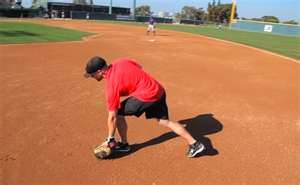
Attack Ball On Glove Side If Possible
(2.) The second baseman will go to first base to receive the return throw from the shortstop.
(a.) Usually the first baseman will be too far from the base to return in time to complete the double play …
(b.) If the first baseman is able to return to the base … the second baseman will circle around behind him to guard against a wild throw.
Third Base:
(1.) The third baseman, depending on whether the ball is hit directly at him, or he is traveling to his left, throws to second base, where the second baseman will allows cover on this play.
*** A few caveats involved in turning a double play.***
(1.) Always try to throw the ball chest high.
(2.) Never remain standing in the base path.
(a.) You’re fair game for the runner to plow you over …
(b.) an inexperienced umpire may even call the runner safe because you interfered with him, complete your throw, move out of the way and always follow the play until it ends.
(3.) Take speed over pretty any day. If you field the ball and can flip or throw it to your shortstop without coming properly set…do so.
(4.) Anticipation and pre-programming is very important and separates the good from the great ball players. Analyze the circumstances.
(a.) If your pitcher throws a blazing fastball, anticipate the right handed batter will swing late which means he’ll hit the ball to your side. Cheat a little to the left.
(b.) If you know there’s a slow runner on first, don’t worry so much about covering on a steal. Concentrate on the batter. What do you think he’ll do.
Baseball has been called a game of inches. Anticipation can take those inches away from your opponent and help you instead.
Double Play to How to Play Infield







New! Comments
Have your say about what you just read! Leave me a comment in the box below.